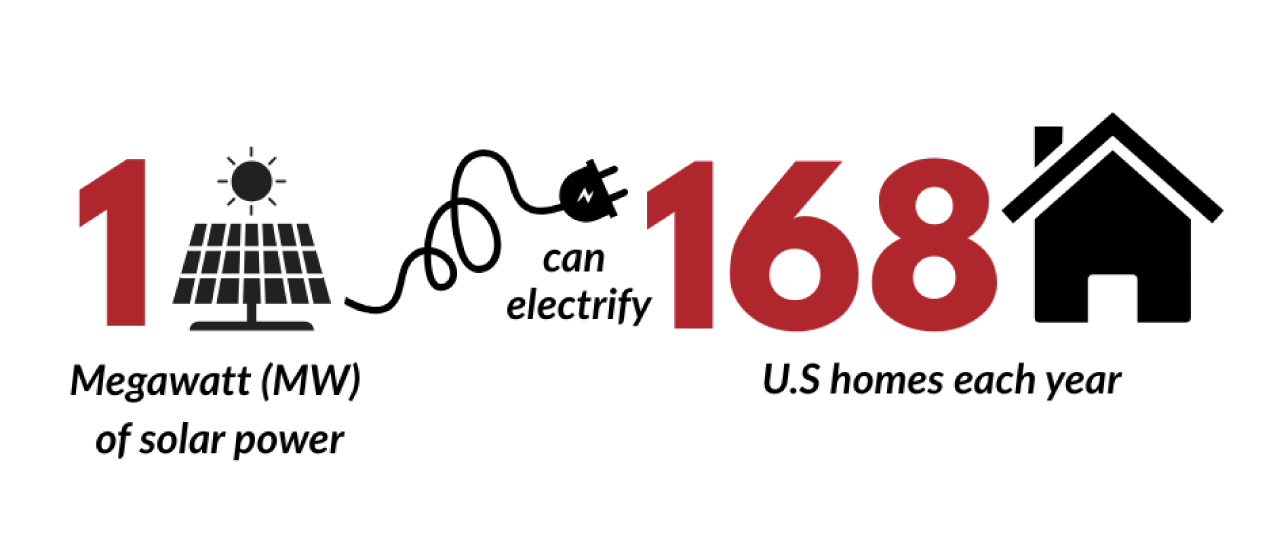Updated: November 3, 2025
Why Solar Trends Matter
Ohio policymakers are shaping our clean energy future right now. Our utility-scale solar trend report keeps you updated on what projects are moving forward, what’s stalled, and how state and local decisions affect communities, jobs, and our grid. Ohio families face rising bill costs and reliability challenges to our grid. Utility-scale solar projects bring new energy, new jobs, and new revenue for schools and services, but only if projects move forward equitably. Here at the Ohio Environmental Council, we’re tracking approvals, proposals, denials, and bans under Ohio’s restrictive siting rules.

What is utility-scale solar?
Utility-scale solar projects generate enough power for tens of thousands of homes.
Why it matters:
- Grid reliability: Utility-scale solar adds large amounts of new generation capacity to a grid facing rising demand from data centers, electric vehicles, and manufacturing growth.
- Affordability: Once built, solar projects produce energy at predictable, low cost, helping stabilize long-term electricity prices.
- Local benefits: These projects bring millions in tax revenue to support schools, emergency services, and infrastructure in rural communities.
- Climate and air quality: Unlike fossil-fuel generation, these projects create clean, zero-emission power, improving public health and cutting pollution.
In short: utility scale solar keeps the lights on, lower costs, and powers economic opportunity, if projects are allowed to move forward responsibly.
2024 and 2025 at a Glance
- Approved in 2024, the Oak Run Solar Project became the largest solar facility ever permitted in Ohio and one of the largest in the Midwest. Once built, the 800 MW project will generate enough clean electricity to power over 130,000 homes, while delivering millions in tax revenue for local schools and services. The project includes battery storage and agrivoltaic research components, marking a major step toward an integrated clean energy future.
- Ohio’s current largest solar project reached full operation (Dec 2024): Fox Squirrel Solar (577 MW) is delivering power to the grid.
- 167.5 MW came online in 2025: Ross Solar (120 MW) and Fayette Solar (47.5 MW) entered operation in June 2025.
- 440 MW approved: 3 new projects certified by the Ohio Power Siting Board (OPSB) (Clear Mountain, Frasier, Eastern Cottontail)
- Over 1,200 MW denied or withdrawn: Richwood, Stark, Grange, and Birch projects pulled back.
- Clean Energy Bans spreading: Clark, Crawford, and Morrow counties enacted restrictions

Clean Energy Bans:
Changes to Ohio law a few years ago through a bill known as “SB 52” now allow county commissioners to ban clean energy outright without any consideration to individual projects.
How it’s being used:
- Preemptive countywide bans. Several counties have passed blanket restrictions rather than evaluating projects on the record. (e.g. Clark County vote in Sept 2025)
- Referendum dynamics. Bans on restricted areas can go to voters, creating long periods of uncertainty that stall projects (e.g. Richland County heading to the May 2026 ballot.)
- Statewide pattern. Since SB 52 took effect, counties have increasingly moved from evaluating projects on their merits to imposing broad exclusions. As of September 2025, 37 counties have passed resolutions creating solar exclusion zones in at least one township, according to Ohio Citizen Action’s county tracker.
- Critics’ concern. Legal and policy analyses warn how certain components of SB 52 can function as a de facto local veto, sidelining OPSB’s evidentiary review in favor of upfront political decisions.
Why it matters: As Ohio’s demand for energy increases, local bans and complicated approval processes make it harder to build new clean energy projects. These delays can create a reliability problem and drive-up costs for anyone who pays an electric bill.

What Does This Mean for Ohio?
Every 1 megawatt (MW) of solar power can supply electricity for about 168 average U.S. homes each year. Based on that estimate:
- Ohio currently has 3,964.6 MW of utility-scale solar online, thus powering roughly 667,000 homes (source: Ohio Power Siting Board)
- Ohio ranks 11th nationally in total installed solar capacity, according to the Solar Energy Industries Association (SEIA). (This ranking includes all solar sources: utility-scale, commercial, and residential)
- In 2025, so far, another 440 MW has been approved, thus powering roughly 74,000 homes
- About 1,200 MW of projects have been withdrawn or cancelled in 2025, which would have powered roughly 200,000 homes
Additional Sources: What’s in a Megawatt – SEIA, Frequently Asked Questions (FAQs) – U.S. Energy Information Administration (EIA)
Approved in 2025
- Clear Mountain Energy Center (100 MW, Clermont Co.) Approved January 16
- Frasier Solar (120 MW, Knox Co.) Approved June 26, rehearing denied on August 21.
- Eastern Cottontail Solar (220 MW, Fairfield Co.) Approved August 21
Proposed and Pending
- Sloopy Solar (180 MW, Clark Co.): Public meetings are underway. County ban complicates future
- Carnation Solar (142 MW, Fairfield Co): Public hearing held on August 11, evidentiary hearing postponed
- Ritter Station Solar (199 MW, Fulton Co.): Evidentiary hearing scheduled September 15
What is the OPSB Approval Process?
Before any large solar project (greater than or equal to 50 MW) can be built in Ohio, it must be certified by the Ohio Power Siting Board (OPSB).
The process includes:
1. Application: Developer files a detailed proposal covering siting, environmental, and community impacts.
2. Staff Review: OPSB staff reviews the project and issues a staff report with recommended conditions.
3. Public Hearing: Residents share support or concerns on the record.
4. Evidentiary Hearing: A formal, courtroom-style proceeding where the developer, OPSB staff, and intervenors present expert testimony and evidence.
5. Board Decision: The OPSB votes to approve, deny, or modify the project, often with conditions designed to protect farmland, wildlife, and communities.
Denied or Withdrawn
- Richwood Solar (250 MW, Union Col) – Denied
- Stark Solar (150 MW, Stark Co.) – Denied
- Grange Solar (500 MW, Logan Co.) – Withdrawn
- Birch Solar (300 MW, Allen/Auglaize Cos.) – Suspended
These losses represent more than a thousand megawatts stalled or removed from Ohio’s energy grid pipeline, at a time when demand for energy is surging, and grid reliability and affordability are under growing pressure.
Recent Clean Energy Bans
- Clark County: Ban on all large-scale solar/wind (September 5)
- Crawford County: County-wide restrictions passed on July 6.
- Morrow County: Ban in five townships (Aug. 25)
- Richland County: Solar and Wind Ban Heads to the Ballot

After months of debate, Richland County’s restriction on large-scale renewable projects is heading to the ballot in May 2026
- Citizen petition certified: The Board of Elections confirmed 3,380 valid signatures, surpassing the 3,320 needed to qualify the issue for a countywide vote.
- Background: In July 2025, county commissioners approved a ban on wind and solar projects in 11 of 18 townships, but the measure quickly drew challenges from residents who say it limits property rights and local economic opportunity
- Next step: Voters will now decide whether to uphold or overturn the ban on “economically significant” wind and solar facilities across unincorporated areas of the county.
- Broader context: The outcome could shape how other Ohio counties approach renewable energy zoning and local control under Senate Bill 52.
These Clean Energy Bans allow counties to block projects before they’re reviewed, putting local tax revenue, jobs, and energy reliability at risk.
What’s Next
- More bans on the horizon: Ongoing hearings in several counties
- Construction mobilization: Recently approved projects move forward with construction and connecting to the grid
- Kingwood Solar at the Ohio Supreme Court: Decision pending on what “public interest” means. This ruling could reshape how the Ohio Power Siting Board (OPSB) weighs local opposition against statewide benefits like grid reliability, clean energy investment, and lower long-term costs. The outcome will set a critical precedent for all future large-scale solar cases in Ohio.

Why the Kingwood Solar Case Matters
At stake: The Kingwood Solar case (175 MW, Greene County) is before the Ohio Supreme Court after the OPSB denied the project in 2022, citing “public interest” concerns. Oral arguments took place on March 13, 2025, and a decision is expected soon.
The core question: What does “public interest” actually mean under Ohio law?
- The OPSB has often treated local government opposition as decisive.
- Developers and clean energy advocates argue that the Board must consider the full public record, including grid reliability, clean energy jobs, consumer costs, and environmental benefits.
Why it matters:
- Ohio’s electricity demand and cost is climbing, and clear, consistent standards are vital for planning reliable and affordable power.
This ruling will determine whether future solar projects are evaluated on statewide evidence of need and benefit, or limited by localized political opposition, a decision that could reshape Ohio’s clean energy pipeline for years to come.
How You Can Help
Your voice matters in public hearings and local decisions.
